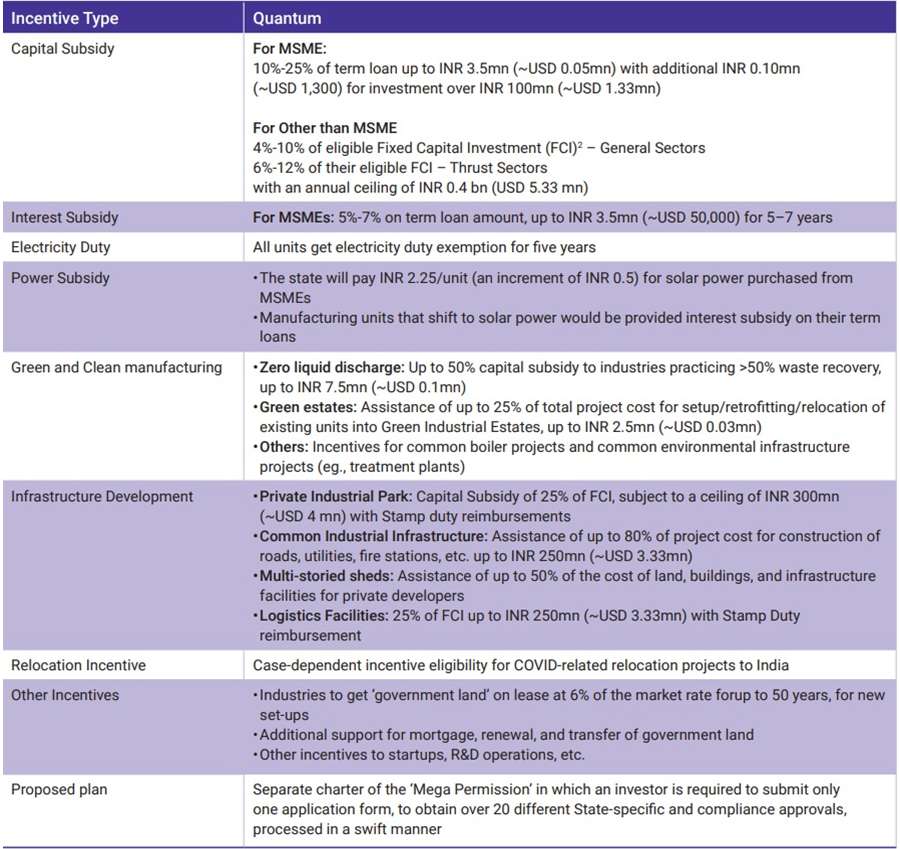Gujarat’s New Industrial Policy: A thrust towards new growth areas
Recognized as one of the most industrially developed states in India which offers a conducive business ecosystem, Gujarat aims to establish itself as a global business destination. The new Gujarat Industrial policy (GIP) 2020 is aimed at further consolidating this momentum and focuses on strengthening MSMEs, promoting cluster development, and fostering entrepreneurship.
- Gujarat has recorded unprecedented growth in terms of FDI inflows, industrial output, export performance, and domestic investments. It was ranked 1st in Export Competitiveness Index 2020 by NITI Aayog and was among the top 5 states in terms of new investments announced in FY 2018-19 according to the ease of doing business 2020 report.
- The new Gujarat Industrial Policy 2020, which came into effect on August 7th, 2020, is aimed at further consolidating this momentum and enhancing the current growth rate. It has a mission to promote entrepreneurship and innovation in the state.
- The policy lays emphasis on promoting the MSME sector, which grew by 60% from 2014-15. It aims to provide a thrust to 16 sectors classified as core and sunrise sectors such as electrical machinery & equipment, industrial machinery & equipment, ceramics, gems & jewelry, waste management projects, and green energy.

Gujarat is home to around 5% of India’s population and contributes almost 8% to India’s GDP. According to the Annual Survey of Industries, with a share of 17%, it ranks first in India in terms of industrial output. Additionally, Gujarat topped the NITI Aayog’s Export Preparedness Index 2020, which evaluates states’ potential and capacities.
Around 40% of India’s cargo is handled at ports in Gujarat, while 20% of the country’s exports come from this state. In terms of FDI inflows, Gujarat witnessed the highest national increment over the previous financial year 2019-20. Hence, the FDI growth in the state is 60 times that of the growth in the rest of India. Between April 2015 and March 2020, it received FDI worth US$ 15.6 billion.
Gujarat is renowned as one of the most industrially developed states in India, which offers a conducive business environment, facilitated by state-of-the-art infrastructure and ease of doing business. The New Gujarat Industrial policy (GIP) 2020 was introduced to further strengthen Gujarat’s manufacturing ecosystem as well as bolster the key thrust sectors. There is a strong emphasis on strengthening MSMEs, promoting cluster development, and fostering entrepreneurship.
The previous industrial policy, which won many accolades for Gujarat, was applicable from 2015-2019 and was extended till the launch of GIP 2020. The new Gujarat Industrial policy is valid for a period of 7 years, starting from August 7, 2020. It is developed with the vision to give a thrust to “Atmanirbhar Bharat” and promote Gujarat as a global business hub for sustainable manufacturing and services industry renowned for state-of-the-art infrastructure, inclusive and balanced regional development and employment generation.
Subsidies and incentives under new Gujarat Industrial Policy

Source: Government of Gujarat
Thrust sectors
Gujarat harbours some of the world’s largest companies, including 100+ fortune 500 companies. It has developed a strong manufacturing base for various sectors. The state government announced more than 20 sector specific policies in the past four years. These policies emphasized enriching of the industrial ecosystem and on encouraging R&D and innovation. Moreover, Gujarat also houses over 3.5 million MSMEs, which have grown by 60% from 2014-15. These are a major source of employment generation.
The thrust sectors mentioned in GIP 2020 are broadly divided into two categories: core sectors and sunrise sectors. The 9 identified core sectors are the ones with an established manufacturing base and significant potential for growth and consolidation of business. These sectors include:
- Gems and jewelry
- Chemicals (designated areas)
- Electric machinery and equipment
- Industrial machinery and equipment
- Auto and auto components
- Technical textiles
- Ceramics
- Agro and food processing
- Pharmaceuticals and medical devices.
The six identified sunrise sectors hold immense potential for technological advancement and can contribute to sustainable economic development. These include:
- 100% export oriented units from any sector
- Waste management projects
- Industry 4.0 manufacturing
- Eco-friendly compostable material (substitute to traditional plastics)
- Electric vehicles and components
- Green energy (solar & wind equipment).
Classifications defined in the new policy
The new GIP 2020 offers wide-ranging incentives to encourage manufacturing units in Gujarat. It classifies enterprises into four categories, and the eligibility for the types and quantum of incentives is based on the type of manufacturing unit, the nature of the business or enterprise and the location of investment. These are classified as follows:
- MSME Project: Investment up to Rs 0.5 billion (~US$ 6.67 mn) and turnover up to INR 2.5bn (~US$ 33.33 mn)
- Large Project: Investment between Rs 0.5 billion (~US$ 6.67 mn) to INR 10bn (~US$ 0.13 bn)
- Mega Projects: Investment between Rs 10 billion (~US$ 0.13 bn) to INR 40bn (~US$ 0.53 bn)
- Ultra-Mega Projects: Investment above Rs 40 billion (~USD 0.53 bn)
From best to par excellence: The road yet to be taken
To sum up, the new GIP 2020 envisions to promote and facilitate industries that prioritize sustainable and cleaner manufacturing and Industry 4.0 practices. It drives Gujarat to become a global manufacturing hub by crafting a blueprint for word-class infrastructure, competitive fiscal incentives, inclusive and balanced regional development, employment generation and strengthening integrated value chains for an Aatmanibhar Bharat. Some steps, like delinking of incentives with SGST amount, support to start-ups, and special incentives for industries relocating to Gujarat etc. are encouraging.
However, Gujarat would also benefit from a few other measures that could go a long way in enhancing manufacturing and, hence, exports from the state. A closer look at the Export Preparedness Index 2020 reveals that Gujarat needs to improve in a few key parameters such as R&D infrastructure, capacity building/orientation workshops, number of trade fairs conducted by government departments, area under export promotion industrial parks, EPZ & SPZ, banking facilities and export credit to exporters.
Therefore, the government must work together with the industry to foster a culture of innovation and boost production. This is crucial at a time when many international companies are seeking to diversify production and competitors like Vietnam & Thailand offer stiff competition.













Leave a comment